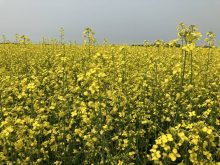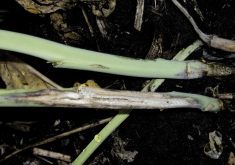Six partnering municipalities in the northeast region have stepped up their clubroot monitoring and are running an enhanced clubroot surveillance program.
“There’s a lot of presence of clubroot in the Edmonton region. There’s a lot more traffic in that area. That’s where it was first discovered and is prevalent,” said Hannah Musterer, agricultural services technician with the County of Vermilion River.
That prompted her county to join up with the counties of Two Hills, Lamont, Lac La Biche and St. Paul and the MD of Provost to boost their surveillance for clubroot — including using innovative technology to see if it is spreading via airborne spores.
“We’re doing enhanced monitoring through pathotype testing and then testing wind and spore movements using a Burkard spore trap,” said Musterer.
Burkard spore traps are used in Europe to monitor soil diseases, and could also be used in Canada to monitor fusarium and other diseases spread by wind. The traps, which capture spores on adhesive tape, were set up for four weeks in the summer.
“At the end of the week, we pull the tape off and have trace amounts of dust and particles on it,” said Musterer. “We partnered with the University of Alberta and we sent in those tapes that we sampled for clubroot soils there.”

The traps were placed near clubroot fields where there was known infection with the goal of finding out if spores were being spread by air movement.
“We placed it beside areas where we had positive plants and positive soil tests,” she said. “We were hoping to get some dust kicked up during harvest and seeding. We put them out two times during the year. We haven’t found anything on those yet. That’s good news.”
Clubroot is also suspected of being able to move via dust, but that didn’t seem to be the case in the group’s test.
“We haven’t been able to test and find it yet, so that’s really good news,” she said.
Read Also

Scouting for disease in canola crops
Inspecting your canola fields for early signs of disease can save you plenty of headaches in the long run.
The group is also doing pathotype testing and sending various clubroot plants to the University of Alberta. These will help the municipalities have a better understanding of how to combat the type of clubroot in their region.
The most common pathotypes of clubroot found in Alberta are 3-H and 3-A. Musterer likens the pathotypes to strains of a common flu.
“Every year it grows, spreads and gets tougher. It’s a disease that changes to survive,” she said.
Most counties are finding more clubroot cases, but more cases are also being found because of the enhanced surveillance, she said.
“As clubroot evolves as a soil-borne disease in Alberta, we are monitoring it more because counties and MDs enforce the pest act. In order to enforce it, we have to find it so we’re doing more inspections.”
Finding clubroot is not about pointing fingers, but about helping people find options on how to control it, she added.
The group is also looking for resistance breakdown in resistant canola varieties in its three-year project, which will conclude this coming year.
Lamont County surveys about 100 fields each year, and finds about 15 to 20 per cent infested with clubroot, said Brett Weeks, the county’s agriculture and environment co-ordinator. The most prevalent pathotypes found in the county are 3-A, 3-H and 8.
“We are starting to see a little bit of resistance breakdown and that is in our Generation 1 genetics,” said Weeks, adding Generation 2 genetics are fairly new to the market and so haven’t had the type of clubroot pressure that accelerates resistance.
The best thing for farmers to do to prevent the spread of clubroot is to plan a good rotation as well as looking for, and killing, volunteers, he said.
“Make sure you are picking a herbicide during your wheat year that is going to get your volunteers,” he said.
Weeks also advised switching between Roundup Ready and Liberty Link canola varieties.
“Switch up your chem options, just to kill off your volunteers,” he said. “It’s not that herbicide resistance is a huge problem, but if you get some herbicide-resistant stinkweed in there, those are also clubroot carriers. That’s important.”
First-generation clubroot-resistant canola is only good for six years, he added.
So he recommends using those genetics for just one year, followed by two years of other crops, and then a canola with second-generation resistance.
“The first generation is probably going to see some breakdown. If there are other virulent types in your field, you won’t be hitting those with your first generation,” he said.
“If you have a rare pathotype in there and you just keep growing what you think is clubroot-resistant canola, it won’t be resistant to the new genetics. You’re only covering yourself for two types of clubroot.
“You could have a third one in there that is just propagating and propagating and propagating, and you need a new genetic package for it.”
And keep a close watch so you can deal with an infestation before it becomes widespread.
“It’s important to monitor it, because if you don’t have any genetics that protect you, you’re going to have a big problem,” he said.
















